 A tropical plant nursery dedicated to the concept
A tropical plant nursery dedicated to the concept
of self-determination and self-sufficiency.
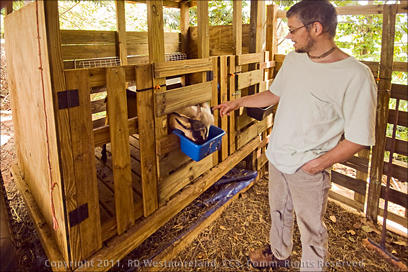 This post is somewhat off topic for a travel site, but like the Tryon Project, Tropic Ventures or the Mayagüez Tropical Ag. Station, I like to feature unique places that the locals might find interesting too.
This post is somewhat off topic for a travel site, but like the Tryon Project, Tropic Ventures or the Mayagüez Tropical Ag. Station, I like to feature unique places that the locals might find interesting too.
If you want to check it out, please contact Sadhu Govardhan through his Web site. I promise it’s worth it.
BTW- He manages the entire farm by himself, including the goats.
I stumbled onto the Govardhan Gardens Web site while looking for sources of tropical fruit and nut seeds. Though there are many nurseries selling seeds outside of Puerto Rico, this one is right here on the island. After a few emails, I finally got the opportunity to meet Sadhu Govardhan. A soft spoken guy with a real passion for gardening and all things tropical.
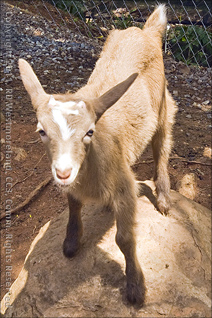 His Web site is vast and worth checking out, even if you don’t plan to visit.
His Web site is vast and worth checking out, even if you don’t plan to visit.
He has written many articles over the years and has a book to his credit: ‘Oro Verde’ Securing the Future of our Food. In addition to the book, selling seeds and potted plants, he also has a goat nursery, assists with finding suitable farm land in PR for those interested as well as a planning service for self-sufficient fruit farming.
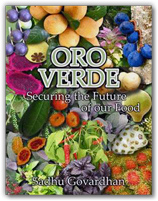 We were there the last week of March so only a few of the fruit bearing trees had any fruit showing.
We were there the last week of March so only a few of the fruit bearing trees had any fruit showing.
We (I) made the mistake of relying on Google Maps to plot a route up to his place for us. We took a rather tangled road (hwy 330) off PR2 and had to backtrack several times. Road signs were pretty much nonexistent. Had we taken Hwy 119 instead, we would have had a much easier time. 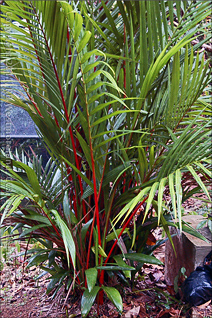 From Mayagüez, you take Hwy 106 all the way to PR 356. We finally got there at 1PM. Going home, we took Hwy 106 to Hwy 119 back down to PR 2 and home via Ponce. A much more direct route, with signs!
From Mayagüez, you take Hwy 106 all the way to PR 356. We finally got there at 1PM. Going home, we took Hwy 106 to Hwy 119 back down to PR 2 and home via Ponce. A much more direct route, with signs!
Govardhan Gardens is located due east of Mayagüez, but well before Maricao or even Las Vegas… yes (unincorporated) Las Vegas, Puerto Rico. 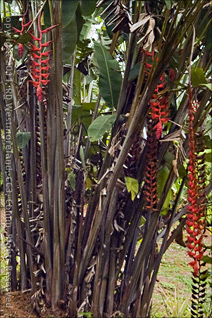 This area has some of the richest farm land on the island and gets lots of rain. Sadhu did say the month of March was very dry. Last year’s total was 132 inches.. way up from previous years. He showed us where erosion had taken out part of the road to the back of his property.
This area has some of the richest farm land on the island and gets lots of rain. Sadhu did say the month of March was very dry. Last year’s total was 132 inches.. way up from previous years. He showed us where erosion had taken out part of the road to the back of his property.
Though the morning started out clear, the weather degraded as the day went on.
Sadhu’s place is spread across 10.5 sloping acres with a main house, a small guest house, a dedicated goat shed with fenced grounds, a plant nursery and the main grounds for all his exotic plants and trees. I won’t bore you with too much hard data, but Sadhu’s collection of Tropical Bamboo exceeds the count of Tropical Bamboo on the grounds of the Tropical Ag. Station in Mayagüez. In fairness, the TropAg Station has more bamboo, but their collection includes Temparate Bamboo as well as Tropical.
The largest tropical bamboo collection on the island.
 His exotic fruit and nut trees now exceed 330 varieties and counting.
His exotic fruit and nut trees now exceed 330 varieties and counting.
I was most impressed with how neat and clean the grounds were. Especially when you consider he does all the work himself. It’s more than I could keep up with.
Our tour started with the goats since we got there during feeding time. The ‘Contented Cows of California’ got nothing on these goats. They looked very healthy and well cared for.
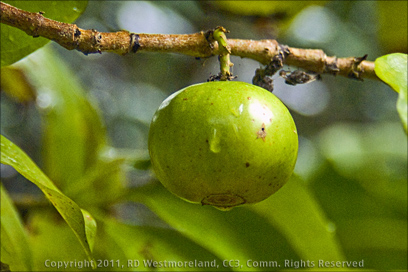 From there, we proceeded down past the main house where he showed us a bed frame made from bamboo. A very hardy structure constructed from Male bamboo (Dendrocalamus strictus) of which he has potted plants to sell.
From there, we proceeded down past the main house where he showed us a bed frame made from bamboo. A very hardy structure constructed from Male bamboo (Dendrocalamus strictus) of which he has potted plants to sell.
We continued on to the main grounds where the sheer number of exotic plants and trees was staggering. So much so, I would have needed to run my little digital note recorder for the entire hike to get it all. I’ve chosen to highlight just a few of the more interesting ones. Much of what I saw was either new to me or I had only read about previously. I have included links with more details regarding each cultivar for those interested.
Strange and wonderful was the order of the day..
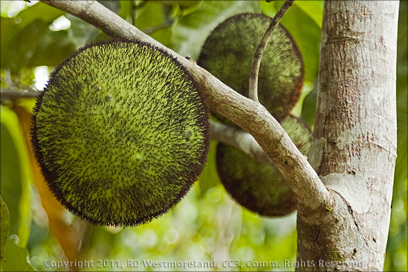 The African Bread Fruit (Treculia africana) shown here can be processed into a cooking flour and used to make flatbread. An average size tree can produce around 25 or more fruit per season. This example is about the size of a cantaloupe, bright green and covered in short black hairs. The trees are monoecious meaning they have both male and female flowers so a single tree will bear fruit.
The African Bread Fruit (Treculia africana) shown here can be processed into a cooking flour and used to make flatbread. An average size tree can produce around 25 or more fruit per season. This example is about the size of a cantaloupe, bright green and covered in short black hairs. The trees are monoecious meaning they have both male and female flowers so a single tree will bear fruit.
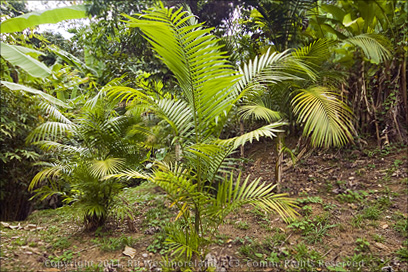 Sadhu had several examples of exotic palms including a few rare Dwarf Acai Palms (Euterpe oleracea). The berry from this short bushy palm has become very popular with health nuts as it contains 4 times the anti-oxidant of the next closest anti-oxidant fruit. Though somewhat bitter, blending them into a smoothie is great. This was the first time I had seen one in the wild. Since these are male/female plants, you need several to bear fruit. The virtues of the Acai palm have been made popular with products like MonaVie. I’ve tried it, it’s very good, but it’s also very expensive.
Sadhu had several examples of exotic palms including a few rare Dwarf Acai Palms (Euterpe oleracea). The berry from this short bushy palm has become very popular with health nuts as it contains 4 times the anti-oxidant of the next closest anti-oxidant fruit. Though somewhat bitter, blending them into a smoothie is great. This was the first time I had seen one in the wild. Since these are male/female plants, you need several to bear fruit. The virtues of the Acai palm have been made popular with products like MonaVie. I’ve tried it, it’s very good, but it’s also very expensive.
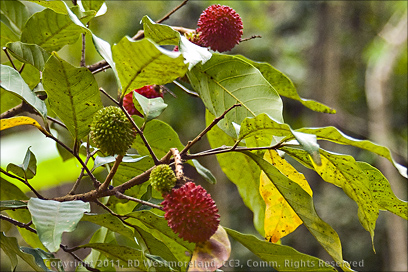 A seasonal fruit I ‘was’ most interested in growing, Rambutan, is one of the species Sadhu keeps several specimen of (30). The fruit ripens from July to October and is a bright red, hairy looking fruit about the size of a plum. I had spotted Rambutan in Walmart, but did not know what it was. Now I wish I had tried it. Its cousin, the much more rare Pulasan (Nephelium mutabile) shown here, is actually bigger, sweeter and the flesh easily comes off the seed which is also edible.. much like an Almond. Too Cool! The leathery outside skin slides off to reveal the firm, creamy white fruit. These are both in the Lychee family. Lychee has been made popular by Chinese restaurants sometimes serving them as dessert. Another ‘must have’ exotic.
A seasonal fruit I ‘was’ most interested in growing, Rambutan, is one of the species Sadhu keeps several specimen of (30). The fruit ripens from July to October and is a bright red, hairy looking fruit about the size of a plum. I had spotted Rambutan in Walmart, but did not know what it was. Now I wish I had tried it. Its cousin, the much more rare Pulasan (Nephelium mutabile) shown here, is actually bigger, sweeter and the flesh easily comes off the seed which is also edible.. much like an Almond. Too Cool! The leathery outside skin slides off to reveal the firm, creamy white fruit. These are both in the Lychee family. Lychee has been made popular by Chinese restaurants sometimes serving them as dessert. Another ‘must have’ exotic.
 Achiote (Bixa orellana), though not quite as outrageous, but still interesting is something the locals use as natural food coloring. It is almost tasteless and adds a warm red to rice and meat dishes. The little reddish brown seeds will stain your hands if you are not carful. Since it’s not a synthetic coloring agent, the FDA does not require certification for use and shows up in many prepared foods. This specimen still had lots of dried, thorny seed pods hanging from it.
Achiote (Bixa orellana), though not quite as outrageous, but still interesting is something the locals use as natural food coloring. It is almost tasteless and adds a warm red to rice and meat dishes. The little reddish brown seeds will stain your hands if you are not carful. Since it’s not a synthetic coloring agent, the FDA does not require certification for use and shows up in many prepared foods. This specimen still had lots of dried, thorny seed pods hanging from it.
Bags of the red seeds are a common sight in local grocery stores.
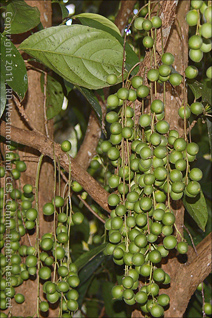 Another very exotic cultivar is the Mentengor Ketupa/Ketoepa (Baccaurea dulcis) from parts of Southeast Asia. They look like clusters of grapes hanging from tree limbs. These immature green fruits will eventually turn a light tan to reddish color. As Sadhu describes it, they taste like a cross between coconut and apricot. He said it is one of his all-time favorites.
Another very exotic cultivar is the Mentengor Ketupa/Ketoepa (Baccaurea dulcis) from parts of Southeast Asia. They look like clusters of grapes hanging from tree limbs. These immature green fruits will eventually turn a light tan to reddish color. As Sadhu describes it, they taste like a cross between coconut and apricot. He said it is one of his all-time favorites.
 Though not quite as exotic as the Menteng, the Malay Apple (Syzygium malaccense) was my favorite. It was in season now so it makes a good transitional fruit for things that come in later. Ripe fruit were laying on the ground. The fruit grows close to the trunk in big clusters. The mature ones did resemble pear shaped red apples and the flesh was firm, somewhat like a pear. Though slightly astringent on first tasting them, it quickly faded to a sweet light flavor. Very delicious. I ate several on the spot. The Malay Apple is a fast growing tree and can reach heights of 40 to 60 feet. I wish there was a dwarf version. Doh!
Though not quite as exotic as the Menteng, the Malay Apple (Syzygium malaccense) was my favorite. It was in season now so it makes a good transitional fruit for things that come in later. Ripe fruit were laying on the ground. The fruit grows close to the trunk in big clusters. The mature ones did resemble pear shaped red apples and the flesh was firm, somewhat like a pear. Though slightly astringent on first tasting them, it quickly faded to a sweet light flavor. Very delicious. I ate several on the spot. The Malay Apple is a fast growing tree and can reach heights of 40 to 60 feet. I wish there was a dwarf version. Doh!
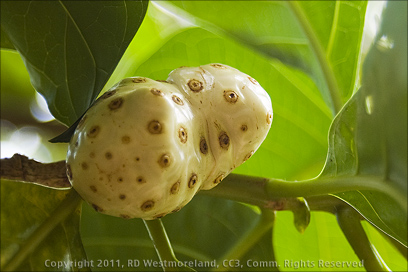 A funny looking fruit from the South Pacific and not quite so rare is the Noni (Morinda citrifolia). They look like they should be from another planet.. maybe an alien embryo? Juice made from Noni is very popular since it is high in anti-oxidants like the Acai berry. Many positive health traits are credited to it… some are in dispute like its ability to help with Cancer. The mature, fully ripened fruit is sweet, but is almost always blended with other fruit juices to help mask it’s somewhat pungent taste. A fermented beverage is also made from it. I have yet to try Noni. I’m sure it’s an acquired taste.
A funny looking fruit from the South Pacific and not quite so rare is the Noni (Morinda citrifolia). They look like they should be from another planet.. maybe an alien embryo? Juice made from Noni is very popular since it is high in anti-oxidants like the Acai berry. Many positive health traits are credited to it… some are in dispute like its ability to help with Cancer. The mature, fully ripened fruit is sweet, but is almost always blended with other fruit juices to help mask it’s somewhat pungent taste. A fermented beverage is also made from it. I have yet to try Noni. I’m sure it’s an acquired taste.
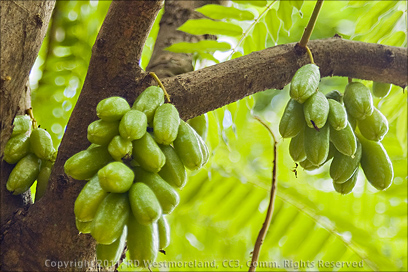 Bilimbi (Averrhoa bilimbi) resembles a narrow Bell pepper and were growing in clusters directly from the tree trunk. Treated more like a vegetable than a fruit, it is very popular in the Philippines. They are often eaten raw as a snack. In many Asian dishes, it’s used as a lemon substitute. It is also sometimes made into a relish and served with rice and beans in Costa Rica. I bet it would be great in Salsa. In Indonesia, a drink is made from it. Bilimbi also has medicinal uses as well. A paste can be made from the leaves to control itching and the fruit has been used in folk medicine to control obesity. Properties that modern medicine is looking into.
Bilimbi (Averrhoa bilimbi) resembles a narrow Bell pepper and were growing in clusters directly from the tree trunk. Treated more like a vegetable than a fruit, it is very popular in the Philippines. They are often eaten raw as a snack. In many Asian dishes, it’s used as a lemon substitute. It is also sometimes made into a relish and served with rice and beans in Costa Rica. I bet it would be great in Salsa. In Indonesia, a drink is made from it. Bilimbi also has medicinal uses as well. A paste can be made from the leaves to control itching and the fruit has been used in folk medicine to control obesity. Properties that modern medicine is looking into.
There was a lot of citrus on the farm..
unfortunately none of it was in bloom yet.
I was there for the Bamboo too!
None of these exotic bamboo should be confused with the bamboo that grows all over Puerto Rico which is an inferior species originally selected for it’s quick growth and adaption to diverse conditions. Since it is high in starch, beetles love it. I’ve written about it in previous posts.
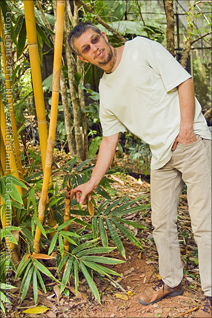 The Golden Bali Bamboo (Schyzostachyum brachycladum) is a rare cultivar I had never seen referenced before. It was starting to throw off large shoots. We also saw examples of Java Black, Dwarf Buddha Belly, Ghost Bamboo and the infamous Guadua (-angustifolia). A strong bamboo used for heavy structural work like bridges.
The Golden Bali Bamboo (Schyzostachyum brachycladum) is a rare cultivar I had never seen referenced before. It was starting to throw off large shoots. We also saw examples of Java Black, Dwarf Buddha Belly, Ghost Bamboo and the infamous Guadua (-angustifolia). A strong bamboo used for heavy structural work like bridges.
By this point we had burned up most of our time when we got caught in the rain (without our rain gear).
 We made a mad dash to Sadhu’s place where he provided us with towels to dry off. He offered us a plate of his home-made goat cheese and crackers while waiting for the rain to subside. It was divine.. extra silky smooth and very light. Similar to a very mild Brie. Nothing like the Gjetost goat cheese I had tried before. It was a real treat.
We made a mad dash to Sadhu’s place where he provided us with towels to dry off. He offered us a plate of his home-made goat cheese and crackers while waiting for the rain to subside. It was divine.. extra silky smooth and very light. Similar to a very mild Brie. Nothing like the Gjetost goat cheese I had tried before. It was a real treat.
Once the rain passed, we headed off to his plant nursery.
I managed to score several potted plants before we left… A Governors Plum, a Cacao plant, a Guarana plant, a Gondo Berry and a Male Bamboo. These are now in the ground and doing well. I plan to add a few more exotics to my garden later in the summer. For the sake of full disclosure, I paid for these out of pocket. Fair is fair.
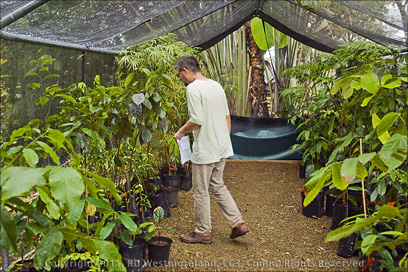 We said our goodbyes about 4PM and headed back down the mountain to the south coast and home.
We said our goodbyes about 4PM and headed back down the mountain to the south coast and home.
If you are a health nut, nature lover, gardener or nature photographer, Sadhu’s place is a must see. Make sure to bring a pair of hiking shoes and an umbrella in case you get caught in the rain like we did. Sadhu is a busy guy so please schedule your visit in advance.
When I come back, I’ll bring a macro lens with LED light and a folding step-stool. Some of the more interesting things are hiding in the dark.
A special Arrg to me First Mate for using a couple of her shots.

bhayali says
Congratulations for going around the Island finding jewels that are doing not only an incredible contribution to Puerto Rico but also leaving a legacy for this and coming generations. (Ed. Note- Thanx for the kind words)
Nydia says
Excellent! I love the article, Sadhu is doing an amazing job!! Two thumbs up!